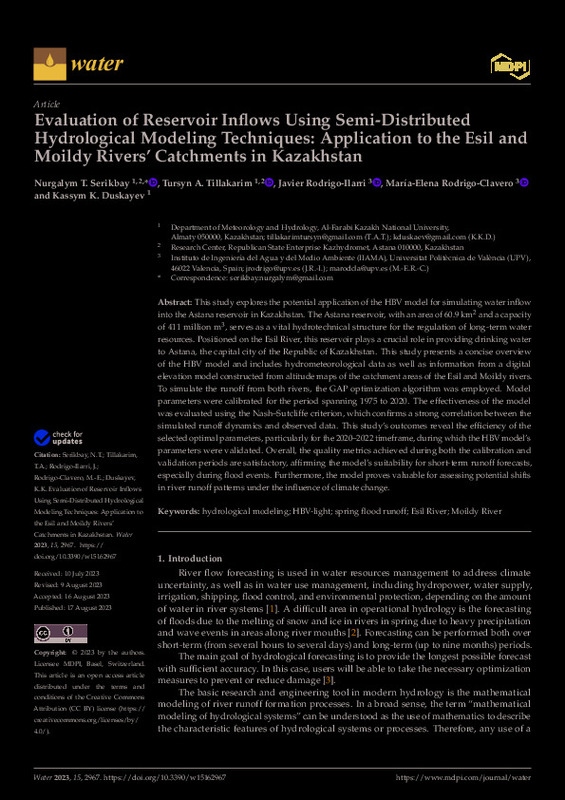JavaScript is disabled for your browser. Some features of this site may not work without it.
Buscar en RiuNet
Listar
Mi cuenta
Estadísticas
Ayuda RiuNet
Admin. UPV
Evaluation of Reservoir Inflows Using Semi-Distributed Hydrological Modeling Techniques: Application to the Esil and Moildy Rivers' Catchments in Kazakhstan
Mostrar el registro sencillo del ítem
Ficheros en el ítem
| dc.contributor.author | Serikbay, Nurgalym T.
|
es_ES |
| dc.contributor.author | Tillakarim, Tursyn A.
|
es_ES |
| dc.contributor.author | Rodrigo-Ilarri, Javier
|
es_ES |
| dc.contributor.author | Rodrigo-Clavero, María-Elena
|
es_ES |
| dc.contributor.author | Duskayev, Kassym K.
|
es_ES |
| dc.date.accessioned | 2024-03-08T11:18:35Z | |
| dc.date.available | 2024-03-08T11:18:35Z | |
| dc.date.issued | 2023-08 | es_ES |
| dc.identifier.issn | 2073-4441 | es_ES |
| dc.identifier.uri | http://hdl.handle.net/10251/203001 | |
| dc.description.abstract | [EN] This study explores the potential application of the HBV model for simulating water inflow into the Astana reservoir in Kazakhstan. The Astana reservoir, with an area of 60.9 km2 and a capacity of 411 million m3, serves as a vital hydrotechnical structure for the regulation of long-term water resources. Positioned on the Esil River, this reservoir plays a crucial role in providing drinking water to Astana, the capital city of the Republic of Kazakhstan. This study presents a concise overview of the HBV model and includes hydrometeorological data as well as information from a digital elevation model constructed from altitude maps of the catchment areas of the Esil and Moildy rivers. To simulate the runoff from both rivers, the GAP optimization algorithm was employed. Model parameters were calibrated for the period spanning 1975 to 2020. The effectiveness of the model was evaluated using the Nash-Sutcliffe criterion, which confirms a strong correlation between the simulated runoff dynamics and observed data. This study's outcomes reveal the efficiency of the selected optimal parameters, particularly for the 2020-2022 timeframe, during which the HBV model's parameters were validated. Overall, the quality metrics achieved during both the calibration and validation periods are satisfactory, affirming the model's suitability for short-term runoff forecasts, especially during flood events. Furthermore, the model proves valuable for assessing potential shifts in river runoff patterns under the influence of climate change. | es_ES |
| dc.language | Inglés | es_ES |
| dc.publisher | MDPI AG | es_ES |
| dc.relation.ispartof | Water | es_ES |
| dc.rights | Reconocimiento (by) | es_ES |
| dc.subject | Hydrological modeling | es_ES |
| dc.subject | HBV-light | es_ES |
| dc.subject | Spring flood runoff | es_ES |
| dc.subject | Esil River | es_ES |
| dc.subject | Moildy River | es_ES |
| dc.subject.classification | INGENIERIA HIDRAULICA | es_ES |
| dc.title | Evaluation of Reservoir Inflows Using Semi-Distributed Hydrological Modeling Techniques: Application to the Esil and Moildy Rivers' Catchments in Kazakhstan | es_ES |
| dc.type | Artículo | es_ES |
| dc.identifier.doi | 10.3390/w15162967 | es_ES |
| dc.rights.accessRights | Abierto | es_ES |
| dc.contributor.affiliation | Universitat Politècnica de València. Escuela Técnica Superior de Ingenieros de Caminos, Canales y Puertos - Escola Tècnica Superior d'Enginyers de Camins, Canals i Ports | es_ES |
| dc.description.bibliographicCitation | Serikbay, NT.; Tillakarim, TA.; Rodrigo-Ilarri, J.; Rodrigo-Clavero, M.; Duskayev, KK. (2023). Evaluation of Reservoir Inflows Using Semi-Distributed Hydrological Modeling Techniques: Application to the Esil and Moildy Rivers' Catchments in Kazakhstan. Water. 15(16). https://doi.org/10.3390/w15162967 | es_ES |
| dc.description.accrualMethod | S | es_ES |
| dc.relation.publisherversion | https://doi.org/10.3390/w15162967 | es_ES |
| dc.type.version | info:eu-repo/semantics/publishedVersion | es_ES |
| dc.description.volume | 15 | es_ES |
| dc.description.issue | 16 | es_ES |
| dc.relation.pasarela | S\498391 | es_ES |
| dc.subject.ods | 03.- Garantizar una vida saludable y promover el bienestar para todos y todas en todas las edades | es_ES |








